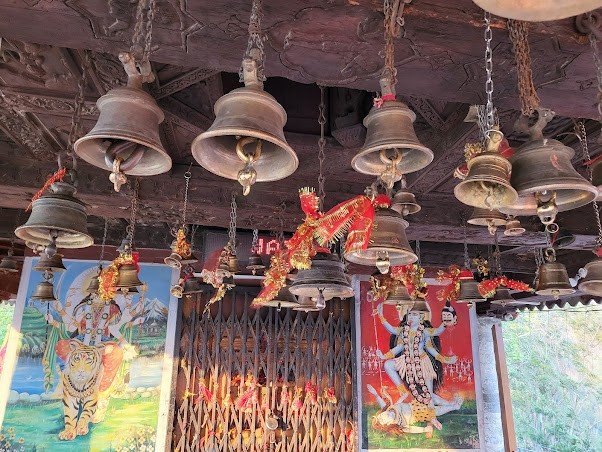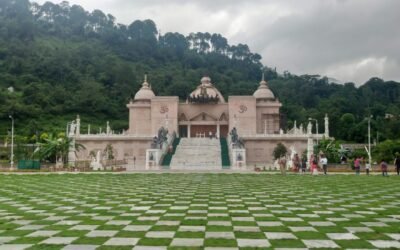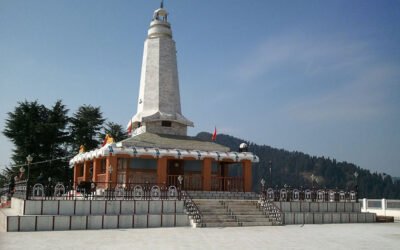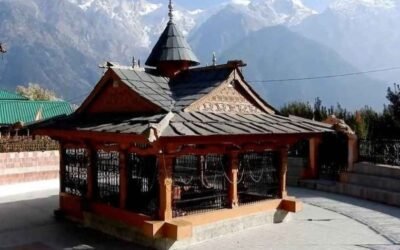Overlooking the picturesque town of Chamba from the heights of Shah Madar Hill, the Chamunda Devi Temple is a powerful symbol of divine protection, feminine energy, and ancient Himachali craftsmanship. Built in 1762 CE by Raja Umed Singh, this wooden marvel is dedicated to Goddess Chamunda, a fierce form of Kali, and is one of the few temples in Himachal constructed entirely of wood.
🌄 Location & Accessibility
- Location: Shah Madar Hill, opposite Chamba town, Himachal Pradesh
- Altitude: ~1,000 meters above sea level
- Nearest Town: Chamba (central location)
- How to Reach:
- By Road: Accessible via a 3 km motorable road or a traditional 378-step stone path
- By Rail: Nearest station – Pathankot (120 km)
- By Air: Gaggal Airport, Kangra (~180 km)
🛕 Mythological Significance
According to legend, Goddess Ambika was meditating atop the hill when demons Chanda and Munda disturbed her. Enraged, she manifested as Kali, adorned in tiger skin and a garland of skulls, and vanquished them. Ambika then declared that Kali would henceforth be worshipped as Chamunda Devi at this very spot.
The temple is also known as Chamunda Nandikeshwar Dham, believed to be the abode of Shiva and Shakti. Statues of Lord Hanuman and Lord Bhairav flank the entrance, guarding the goddess’s sanctum.
🕉️ Deity & Worship
The Chamunda Devi Temple is dedicated to Goddess Chamunda, a fierce manifestation of Durga, who vanquished the demons Chanda and Munda, earning her the name Chamunda. The sanctum houses a stone idol of the goddess, depicted with multiple arms, each holding symbolic weapons, and adorned with a crown, garlands, and ornaments, radiating divine power and protection.
Worship rituals include daily aartis, incense offerings, red cloth, and ghee lamps, with devotees seeking strength, protection from evil, and spiritual well-being. The temple becomes especially vibrant during Navratri, when special pujas, processions, and community feasts are held in her honor. Pilgrims often offer coconuts, bangles, and silver tridents, invoking the goddess’s blessings for courage, justice, and the removal of obstacles. The temple’s sacred pond and nearby shrines to Shiva, Ganesha, and Hanuman further enrich its spiritual landscape.
🏛️ Architectural Highlights
- Constructed entirely of wood, with a gable roof and intricate carvings
- The inner sanctum is adorned with silver sheet engravings and floral motifs
- A cave-like scoop at the back houses a Shiva lingam, symbolizing the union of Shiva and Shakti
- The temple complex includes a handicrafts center selling Kangra paintings, wooden toys, and black pottery
🕉️ Deity & Worship
- Goddess Chamunda is worshipped as the slayer of evil and protector of the righteous
- Devotees offer red cloth, coconuts, and incense, and perform aarti at sunrise and sunset
- The temple is especially revered by those seeking courage, justice, and spiritual strength
🎉 Festivals & Celebrations
- Navratri (Chaitra & Ashwin): The most vibrant time, with thousands of pilgrims, devotional music, and community feasts
- Daily Aartis: Held in the morning and evening, accompanied by conch shells and temple bells
- Special Pujas: Performed during eclipses and full moon nights
🏞️ Nearby Attractions
- Laxmi Narayan Temple: A 10th-century marvel in the heart of Chamba
- Bhuri Singh Museum: Showcasing Pahari art and manuscripts
- Champavati Temple & Akhand Chandi Palace: Rich in history and royal heritage
- Manimahesh Yatra Base: Chamba serves as a gateway to this sacred pilgrimage
🙏 Spiritual Experience
The Chamunda Devi Temple is more than a shrine—it’s a spiritual fortress, standing tall against time and turmoil. The panoramic views of Chamba, the whispering deodar forests, and the fierce yet compassionate gaze of the goddess create an atmosphere of divine awe and inner strength.




